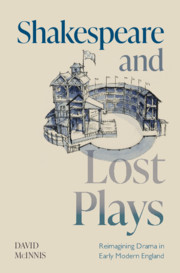Book contents
- Shakespeare and Lost Plays
- Shakespeare and Lost Plays
- Copyright page
- Dedication
- Contents
- Figures and Tables
- Acknowledgements
- A Note on Conventions for the Titles of Lost Plays
- Introduction
- Chapter 1 Charting the Landscape of Loss
- Chapter 2 Early Shakespeare: 1594–1598
- Chapter 3 Shakespeare at the Turn of the Century: 1599–1603
- Chapter 4 Courting Controversy – Shakespeare and the King’s Men
- Chapter 5 Late Shakespeare: 1609–1613
- Chapter 6 Loose Canons
- Conclusion
- Index
Chapter 3 - Shakespeare at the Turn of the Century: 1599–1603
Published online by Cambridge University Press: 10 March 2021
- Shakespeare and Lost Plays
- Shakespeare and Lost Plays
- Copyright page
- Dedication
- Contents
- Figures and Tables
- Acknowledgements
- A Note on Conventions for the Titles of Lost Plays
- Introduction
- Chapter 1 Charting the Landscape of Loss
- Chapter 2 Early Shakespeare: 1594–1598
- Chapter 3 Shakespeare at the Turn of the Century: 1599–1603
- Chapter 4 Courting Controversy – Shakespeare and the King’s Men
- Chapter 5 Late Shakespeare: 1609–1613
- Chapter 6 Loose Canons
- Conclusion
- Index
Summary
The Chamberlain’s Men moved to a new playhouse at the end of the 1590s: the Globe. The association of Henry V and Hamlet with Shakespeare and the Globe has, I argue, distorted our perception of their place in London’s theatrical marketplace. By putting Shakespeare’s plays into some unexpected dialogues with lost plays, I aim to defamiliarize Henry V and Hamlet and trace new sets of associations between their subject matter (and form) and the plays of other companies. Specifically, I argue that Henry V can be seen as the culmination of Shakespeare’s 1590s romance comedies as much as of the Henriad, and that it can thus be regarded as a continuation of the 1590s rather than a turn-of-the-century play intended for the Globe (and thus, by implication, a break with the past). Likewise, Hamlet can be seen as participating in a ‘Danish matrix’ of 1590s plays that playgoers would recognise as having its own set of expectations and concerns. Furthermore, in proposing a new identification of the likely subject matter of ‘felmelanco’, I argue that the fact of the Danish prince having studied at Wittenberg seems to speak importantly to a hitherto underappreciated repertorial context preoccupied with theology in 1602.
Keywords
- Type
- Chapter
- Information
- Shakespeare and Lost PlaysReimagining Drama in Early Modern England, pp. 89 - 117Publisher: Cambridge University PressPrint publication year: 2021



